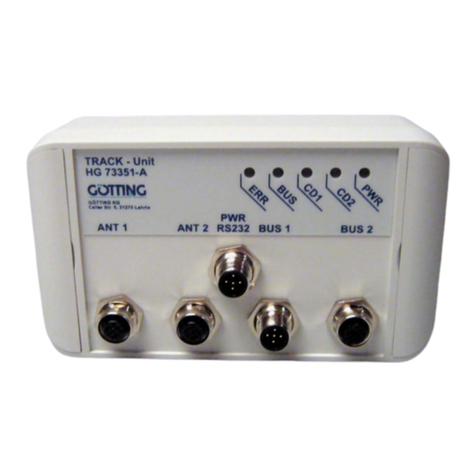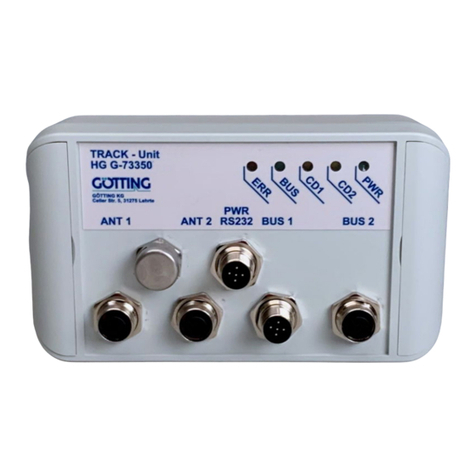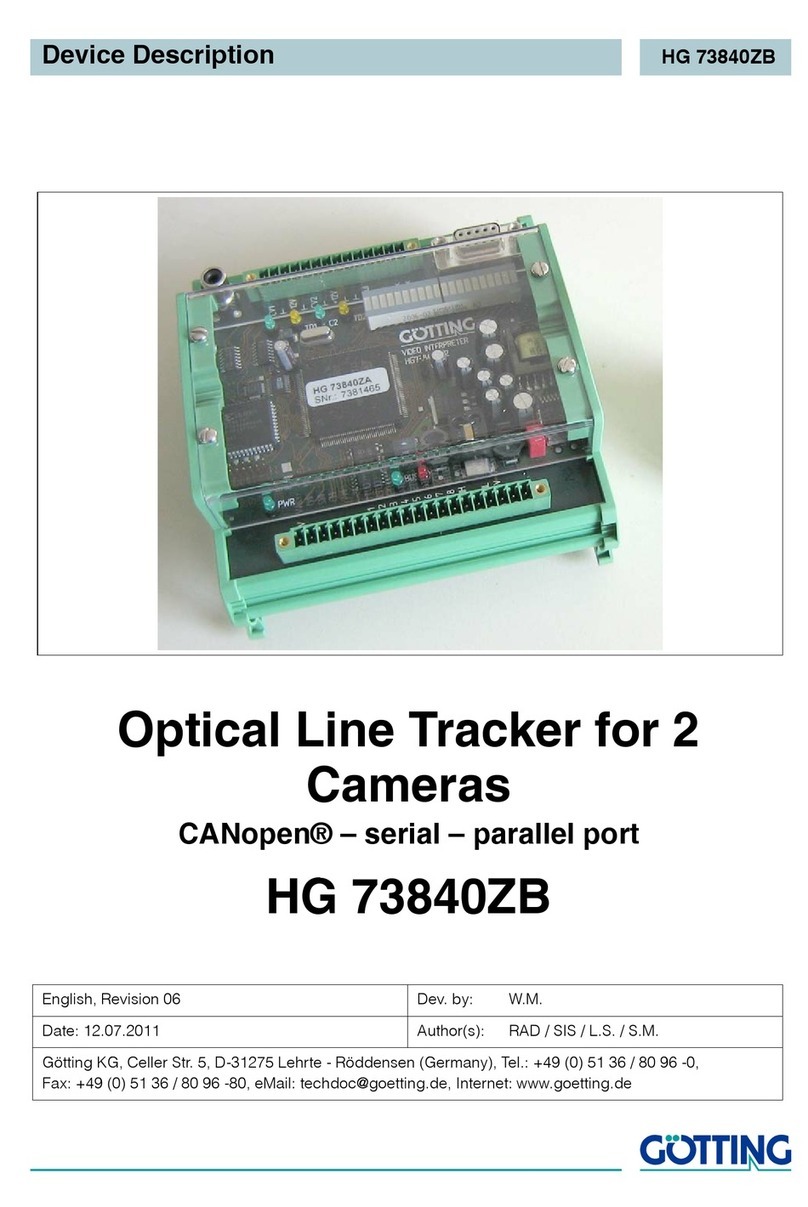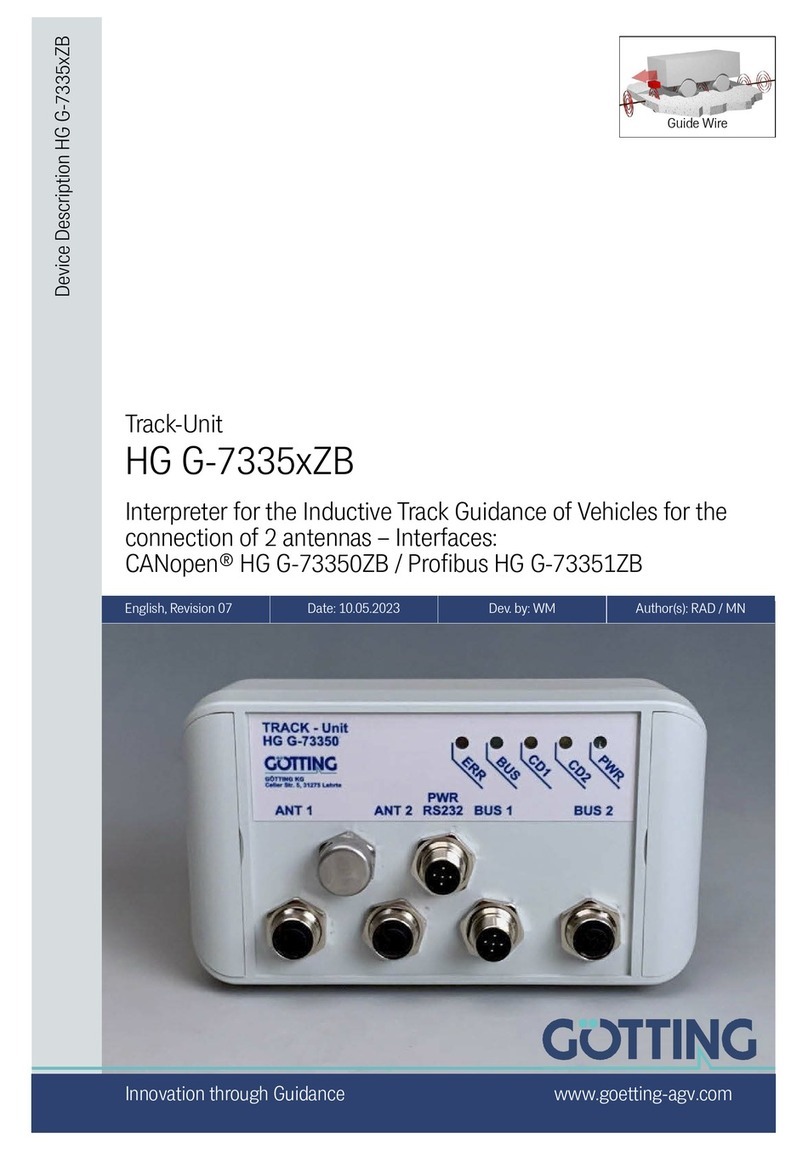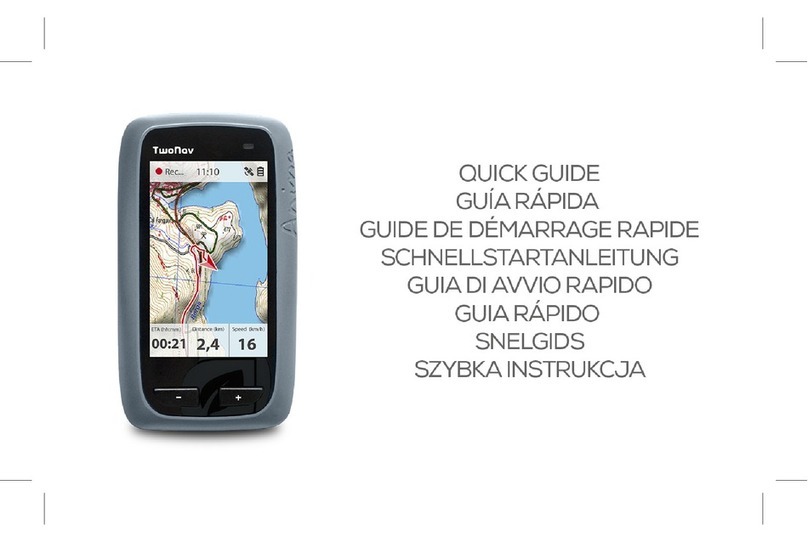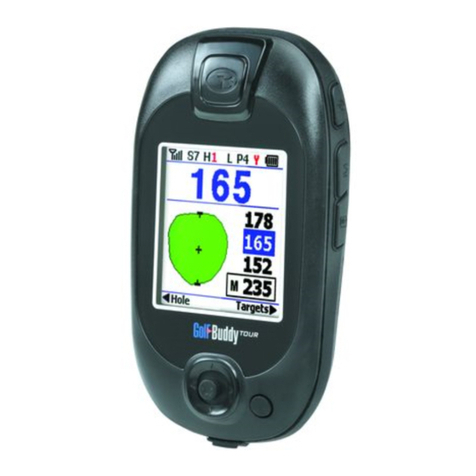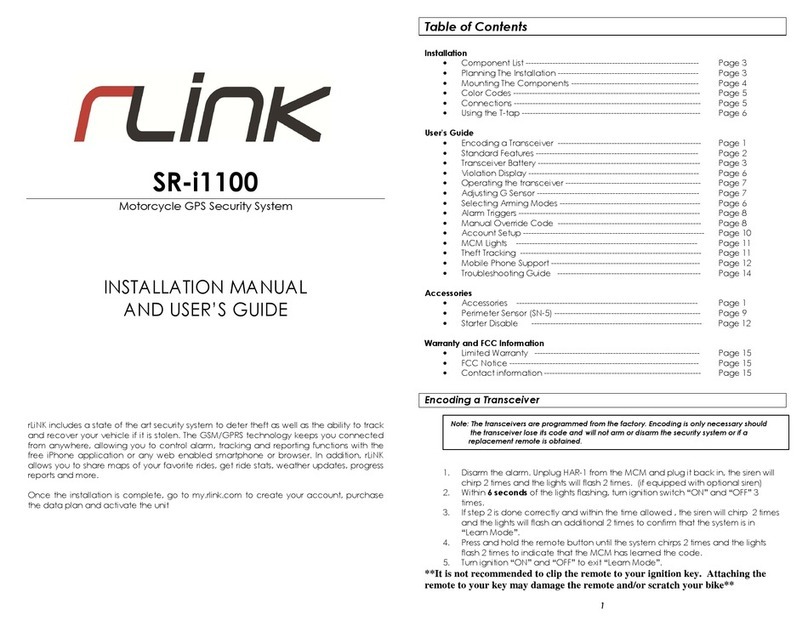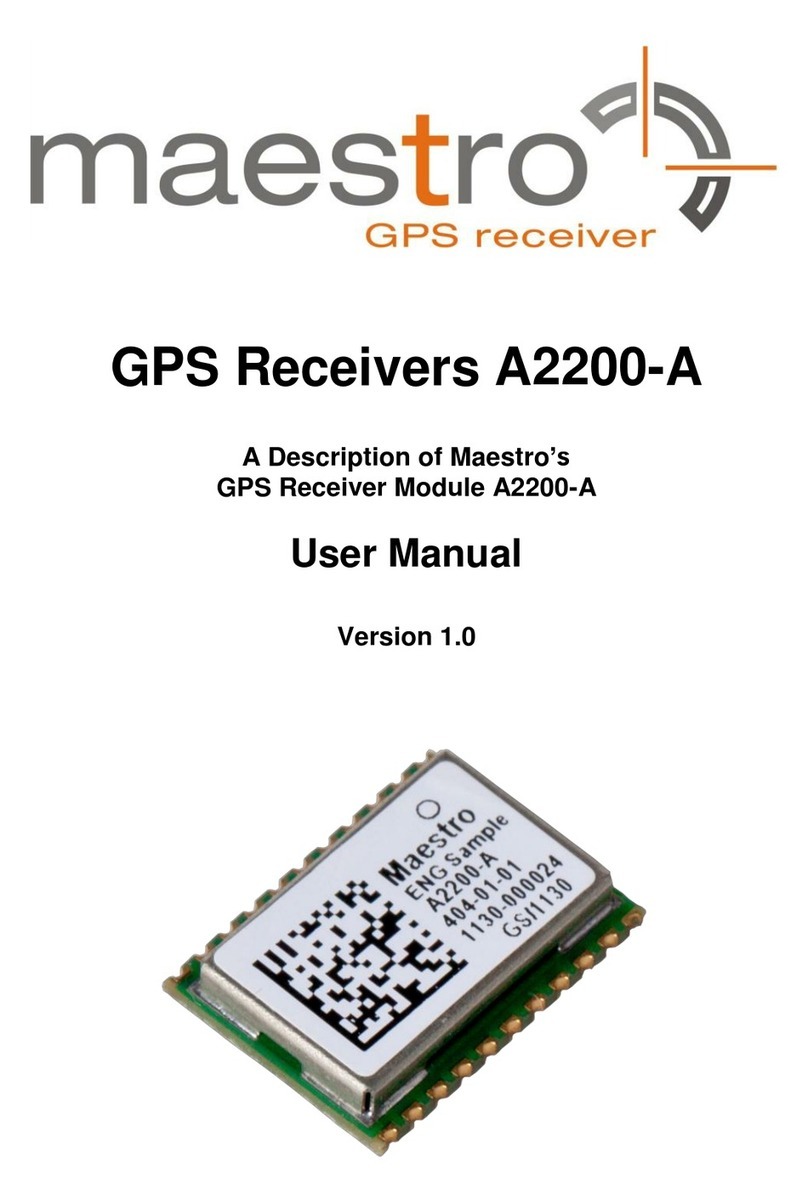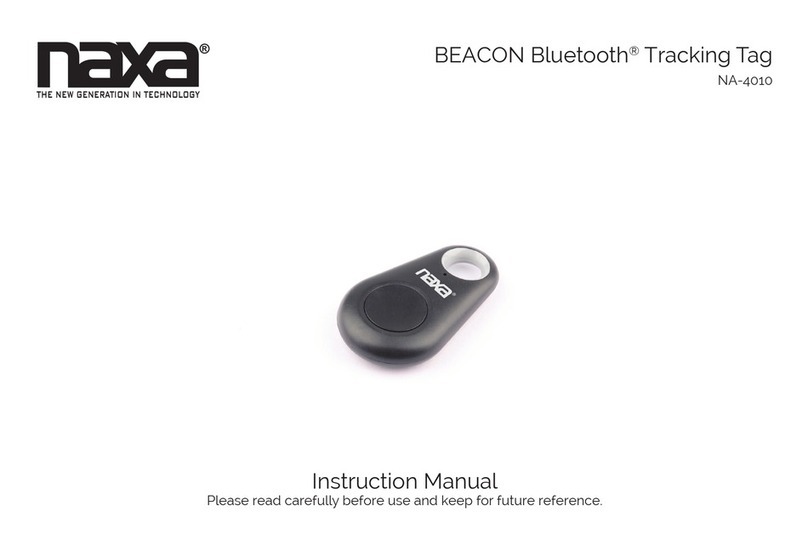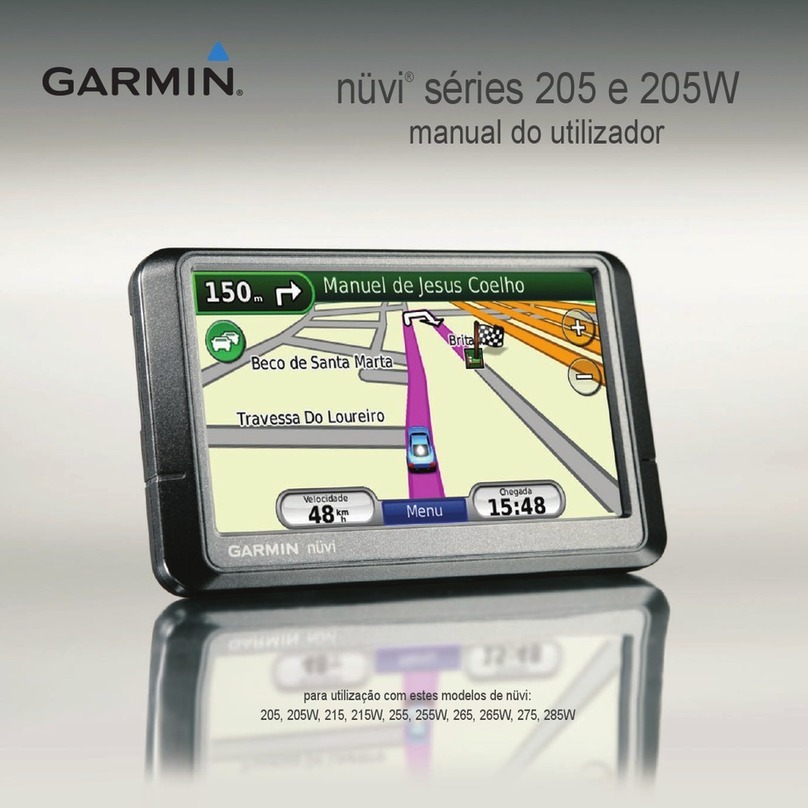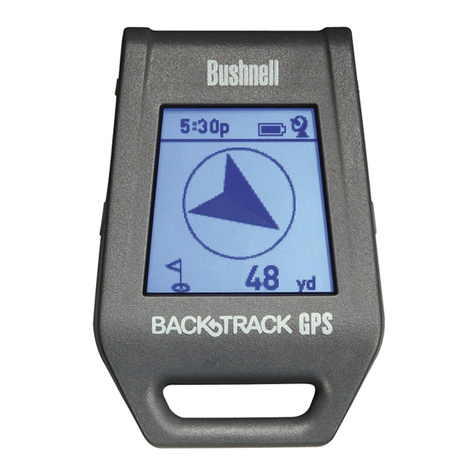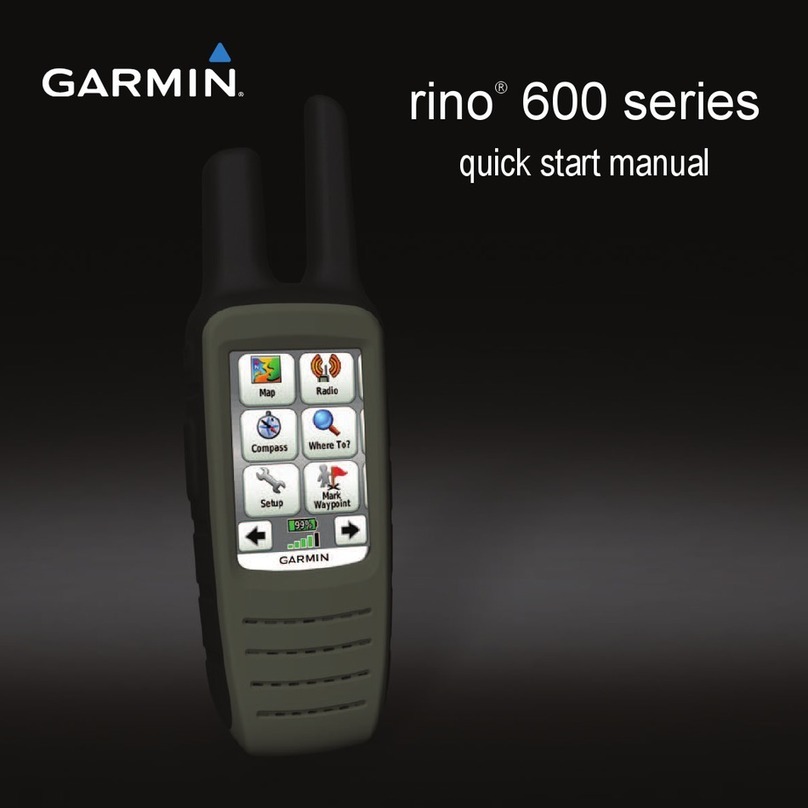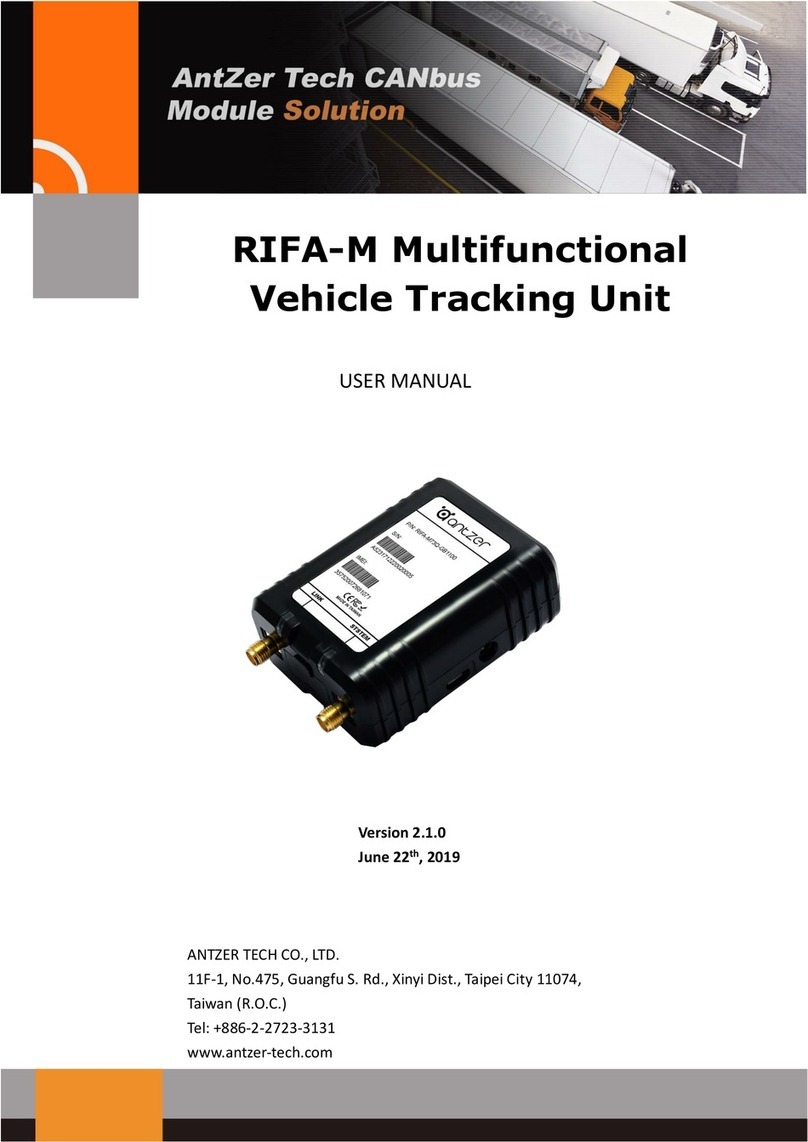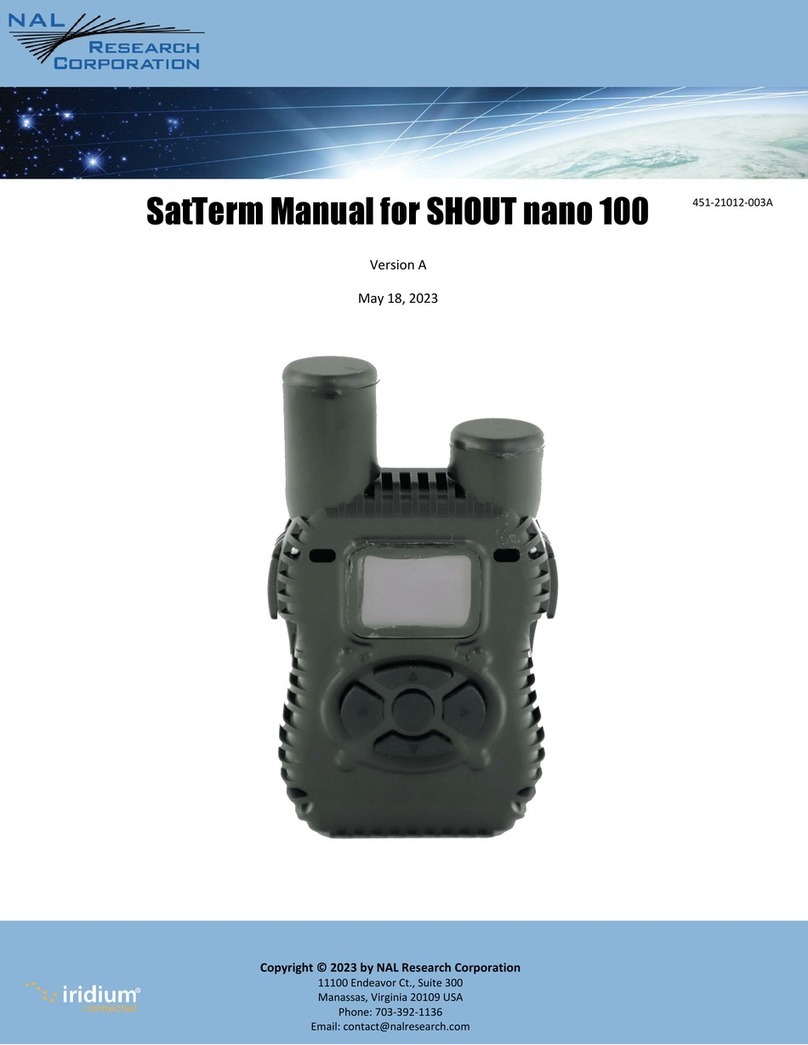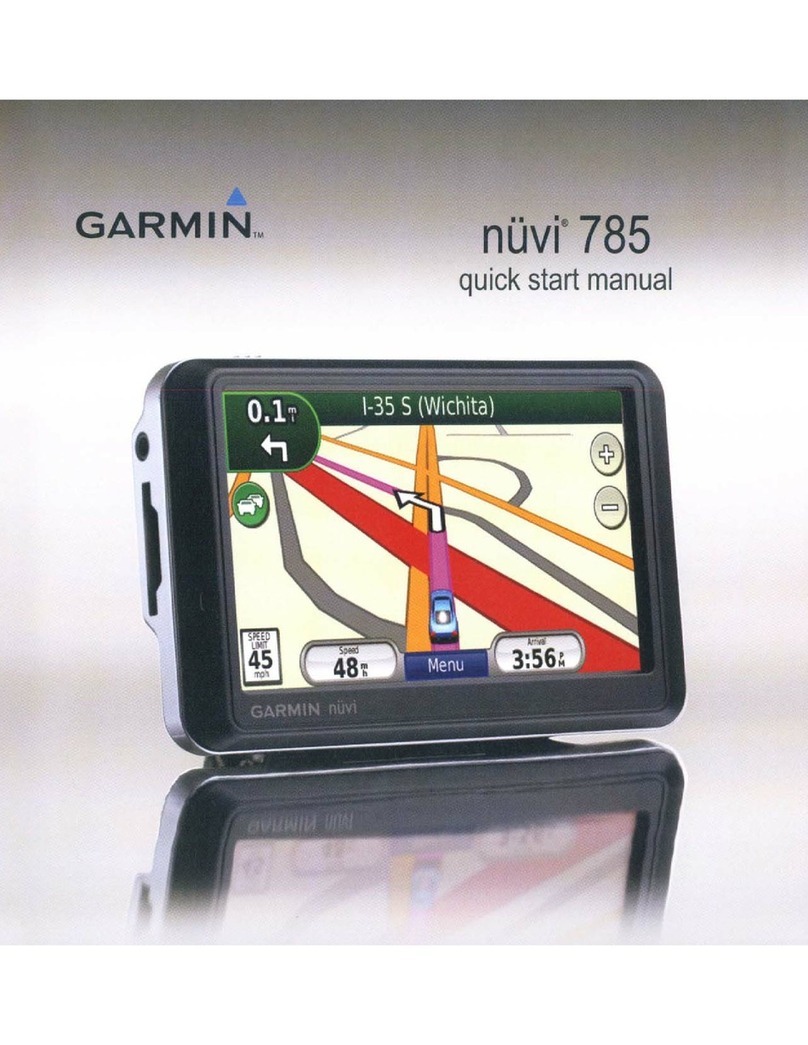Gotting HG G-21934 User manual

Contents HG G-21934
Revision 04 (English), Date: 26.04.2016 2
Contents
1 Introduction.......................................................................4
1.1 System Components............................................................... 4
1.2 Functional Description ............................................................ 4
2 Components and Operation ...............................................5
2.1 Components in the Ground ..................................................... 5
2.2 The Installation Components................................................... 6
2.2.1 Loop Adaptor HG 94210 ................................................................ 6
2.2.2 Track Guidance Generator HG 57400 ............................................7
2.2.2.1 Frequency Setting..................................................................... 7
2.2.2.2 Loop Current and Impedance .................................................... 7
2.2.2.3 Front Plate Elements ................................................................ 8
2.2.2.4 Short-circuit or Cable Break ...................................................... 8
2.2.2.5 Connection Plan for the Generator ............................................ 8
2.3 Components on the Vehicle (Antenna HG 19534) .................... 9
2.3.1 Connection Plan of the 12+1 Pin Socket....................................... 10
2.3.2 External signal processing (not included within the systems scope of
delivery) ...................................................................................... 10
2.3.3 Error Influence............................................................................. 11
3 Mounting.........................................................................13
3.1 Mounting Instructions for Guide Wire..................................... 13
3.2 Mounting the loop adaptor HG 94210 .................................... 13
3.3 Mounting the Track Guidance Generator HG 57400............... 13
3.4 Mounting the Track Guidance Antenna HG 19534 ................. 14
4 Set-Up ............................................................................15
4.1 Setting the track Guidance Generator.................................... 15
4.2 Calibrating the Track Guidance Antenna ............................... 15
5 Fault Finding ...................................................................16
6 Technical Data ................................................................17
6.1 Loop adaptor HG G-94210 .................................................... 17
6.2 Generator HG G-57400......................................................... 17
6.3 Antenna HG G-19534 ........................................................... 18

Contents HG G-21934
Revision 04 (English), Date: 26.04.2016 3
7 Appendix.........................................................................19
A Course taken by Sum and Difference Voltage of a crossed coil ...... 19
B Course taken by Sum and Difference Voltage of a Compensated Cros-
sed Coil ............................................................................................ 19
8 Handbook Conventions....................................................21
9 Copyright and Terms of Liability ......................................22
9.1 Copyright.............................................................................. 22
9.2 Exclusion of Liability ............................................................. 22
9.3 Trade Marks and Company Names........................................ 22
10 List of Pictures ................................................................23
11 List of Tables ..................................................................24
12 Index ..............................................................................25

Introduction HG G-21934
Revision 04 (English), Date: 26.04.2016 4
1 Introduction
The herein described system is especially suited for vehicles working in an outdoor
environment. The electronic unit within the antenna casing is fully submerged in a seal-
ing compound. All important adjustments are carried out via sealed potentiometers.
1.1 System Components
The track guidance system consists of mainly three different components:
-Track guidance antenna(s) HG 19534
-Ground unit with guide wire, loop adapter HG 94210 and possibly an end resis-
tance HG 97110
-Track guidance generator(s) HG 57400
1.2 Functional Description
A rotationally symmetric, alternating magnetic field is produced when the guide wire
is connected over the loop adapter to the generator. The steering antenna receives
over separate channels the vertical and horizontal components of this field. Both com-
ponents are then filtered, strengthened and rectified, so that Usum and Udif are avail-
able at the output pins.
Furthermore there is a switchable output, which validates the output voltage. The re-
ception range is given by the measured sum voltage and is like this voltage; interde-
pendent upon the height and current used. It is possible to select one of eight possible
receiving frequencies by use of the three frequency select inputs.
In order to compensate for height or current fluctuations, a correction calculation has
to be carried out with an external computer, because the given voltages are interde-
pendent on height and current.
In order to register the vehicles angle in relation to the guide wire, a second antenna
should be connected to the vehicle. The correction calculation and calculation of the
vehicles angle is not part of this system.

Components and Operation HG G-21934
Revision 04 (English), Date: 26.04.2016 5
2 Components and Operation
2.1 Components in the Ground
The accuracy of the system is effected by
-large metallic objects on the ground
-metallic reinforcements within a close area of the guide wire.
Inductive loops have a large influence on the system's accuracy, (such as those
caused by steel mating). Individual metal bars have lesser effect upon the system.
Environmental conditions have no effect upon the system e.g.
-snow, ice, water
-oil, tar, sand, soil, dirt and such
There are however restrictions to the permissible length of the guide wire and their sur-
roundings, which will be described in more detail later.

Components and Operation HG G-21934
Revision 04 (English), Date: 26.04.2016 6
2.2 The Installation Components
2.2.1 Loop Adaptor HG 94210
The loop adaptor is contained within an aluminium casing, size 120 x 122 x 91 mm. It
is fitted with two PG plugs, one for the RG 213 coax cable from the generator and the
other for both ends of the loop conductor 2,5 mm². The casing should be earthed as
the voltage over-load is connected to it.
The Coax Cable RG 213 should not be longer than 30 m and the loop conductor to the
guide wire should not be longer than 10 m in length.
Connection Function
1Loop
2Coax RG213 core (from Generator)
3Coax RG213 shield (from Generator)
4Loop
Casing Ground
Table 1 Connection Plan for the Loop Adaptor
35
122
120 30
PG9 PG16
10
Ø4
(Gesamthöhe) 91mm
X2
X113 2 4
1
5
Total height 91 mm

Components and Operation HG G-21934
Revision 04 (English), Date: 26.04.2016 7
2.2.2 Track Guidance Generator HG 57400
2.2.2.1 Frequency Setting
2.2.2.2 Loop Current and Impedance
Long loop: Impedance 0 to 75
Short loop: Impedance 0 to 15
For short loops the loop current can be up to 600 mAeff. By long loops the maximum
currant is 300 mAeff. In this case the definition long or short loop is not based on the
actual length of the loop but on the chosen connections.
In general when a loop is connected to the outputs loop end long and loop start, with
a loop current of 300 mAeff, the actual loop can be as long as is wished up to a maxi-
mum impedance of 75 .
By higher currents more than 300 mAeff the outputs „loop short“ and „loop start“ have
to be used. The maximum impedance here is 15 for a 600 mAeff loop current.
A load impedance greater than 75 can be compensated by connecting a conden-
sator to the circuit board. In order to do so the loop has to be connected to the output
„loop end long compensated“. The capacity of the condensator has to be worked out
individually from case to case.
Position of the
HEX switch Frequency/Hz Position of the
HEX switch Frequency/Hz
05050 87000
15100 97500
25150 A7800
35200 B8000
45700 C8500
56000 D9000
66300 E9500
76500 F10000
Table 2 Frequency Setting

Components and Operation HG G-21934
Revision 04 (English), Date: 26.04.2016 8
2.2.2.3 Front Plate Elements
Figure 1 Front plate HG 57400
24V shows that power supply is on
O.K. correct load impedance
Z<Zmin short- circuit or load impedance too low
Z>Zmax cable break or load impedance too high
Frequenz Frequency setting (see Table 2 on page 7)
2.2.2.4 Short-circuit or Cable Break
A low load impedance is indicated by the red LED „Z<Zmin“. Tran-
sitional resistances amongst other things add to the load imped-
ance of a system; therefore it is not guaranteed that a short-circuit
would be indicated. High load impedances are detected as an in-
terruption within the loop and are indicated by the red LED „Z>Z
max“. In the normal load range the green LED „O.K“. is lit. The detection range is de-
pendant upon the chosen outputs and current rate.
Load impedance range when connected to loop end:
For the correct detection of cable break or short-circuit the actual required current and
size of impedance should be known, so that the generator can be set to these require-
ments.
2.2.2.5 Connection Plan for the Generator
LED Short (I = 600 mA) Long (I = 300 mA)
LED Z<Zmin –0 to 3
LED O.K. 1 to 15 3 to 75
LED Z>Zmax > 15 > 75
Table 3 Load Impedance Ranges of the Generator
Connection Plan (according to DIN 41612, Form C, 64 pins, ac-equipped)
1ac +24 V 25ac Loop Start
2ac 26ac
15ac Loop End Long 31ac Ground
16ac 32ac
20ac Loop End Short
21ac
Table 4 Connection plan generator

Components and Operation HG G-21934
Revision 04 (English), Date: 26.04.2016 9
2.3 Components on the Vehicle (Antenna HG 19534)
The antenna and the electronics are built into a casing, size 120 x 122 x 91 mm. The
reading side is the case's top (lid). The 12+1 pin M3 plug connector points in direction
of travel.
Figure 2 Sketch showing dimensions of the antenna HG 19534

Components and Operation HG G-21934
Revision 04 (English), Date: 26.04.2016 10
2.3.1 Connection Plan of the 12+1 Pin Socket
The connection plan for the system used is:
The current consumption is approx. 100 mA. The input Fsel 1 to 3 for selection of a loop
frequency have to be connected according to the following table:
Pin 9 is an electronic switchable contact to +24 V and has a limited current output of
20 mA. It is switched to +24 V when a guide wire with the correct current and frequen-
cy settings, is detected. It is possible to set the detection threshold via a potentiometer.
The capacity and offset of the DC voltages Usum and Udif are in the range ±10 V se-
table over potentiometers.
2.3.2 External signal processing (not included within the systems
scope of delivery)
As it can be seen from Figure 6 on page 19 in the annex, the course, the difference
voltage takes between its maxima is on the whole linear. The maxima occur in both di-
rections exact at the point designated by the installation height, therefore with an in-
stallation height of 200 mm the maximums occur 200 mm left and right of the wire.
Pin # Function Pin # Function
1+24 V 8 Do not connect.
2GND 9„Guide wire detected“
3 Fsel1 *) 10 Fsel3 *)
4 Fsel2 *) 11 Usum
5Do not connect. 12 Udif
6Do not connect. PE Shield
7Do not connect.
*) = as it is of advantage for large loops to use as low a frequency as possible,
Fsel 1-3 should be left unconnected. They are internally connected over a 10
KOhm resistor to GND.
Table 5 Connection Plan of the 1+1 Pin Socket
5100 Hz 5700 Hz 6300 Hz 7000 Hz 7800 Hz 9000 Hz 10000 Hz 12000 Hz
Fsel1 O + O + O + O +
Fsel2 O O + + O O + +
Fsel3 O O O O + + + +
- O = connect pin with GND or leave open
- + = connect pin with +24 V
Table 6 Frequency selection over the three Fsel inputs

Components and Operation HG G-21934
Revision 04 (English), Date: 26.04.2016 11
From this we see, that the rate of climb of the difference voltage course is dependant
upon the installation height of the antenna, the size of the maxima are also proportional
to the current rate used.
There are therefore the following unknown variables, right angular deviation (requires
to be calculated), height above guide wire (varies according to vehicle load) and cur-
rent rate within guide wire (can be measured and is, when using a suitable adaptor on
the whole constant). For the solution of this there are 2 field equations for the horizontal
and vertical components available.
Under consideration of the sum voltage, it is possible to calculate the right angular de-
viation irrespective of the height (= height compensated) or irrespective of the guide
wire current (= current compensated).
However under certain conditions it may not be possible for a PLC to calculate the re-
quired equations, the following approximations can be carried out:
NOTE! These approximations only work with a constant current input
and a height variation of max. 1.5.
•When the sum voltage drops below 80 % of the maximum level, the difference
voltage is multiplied by 1.2.
•When the sum voltage drops below 60 % of the maximum level, the difference
voltage is multiplied by 1.6.
•When the sum voltage droops below 40 % of the maximum level, the difference
voltage is multiplied by 2
Those levels are examples. They are shown in the annex as three graphs (Figure 7 on
page 19 to Figure 9 on page 20). The antenna is calibrated as follows.
-Guide wire current = 300 mA; height above guide wire = 200 mm; switchable out-
put set at approx. 3,3 V sum voltage.
2.3.3 Error Influence
-The described system shows an antenna and is unable to determine a difference
between useful and interfering signals on the same frequency.
-Furthermore the influence on the system caused by the return side at the guide
wire is to be taken into consideration. This side causes an offset factor within the
magnetic field and should have a distance between outwardside and returnside
of 100 x the reading height between antenna and guide wire.
-On a long loop (e. g. by 5 kHz > 500 m), which is not fitted with a wave resistance
at its end, standing waves are formed. E. g. it appears that in a loop of length /4
(1/4 wave) that at the input point no current flows but at the end maximum current
flows. A height compensated calculation would in this event not be possible. In
order to avoid stand waves a wave resistance (adaptor resistance) is to be fitted
to the guide wire at the furthest point from the generator, because the wave
impedance is relative to the geometrical layout of the loop; the adaption will only
work, if this layout is symmetrically built. This means that the return leg of the loop
should always be laid with a constant spacing from the outward leg.

Components and Operation HG G-21934
Revision 04 (English), Date: 26.04.2016 12
-More often in large installations there are also neighbouring loops in operation. As
the generators are not phase rigidity interconnected, they make themselves
noticed as suspensions within the field. To avoid this it is possible to set the fre-
quencies with ±50 Hz steps. On the one side this stepped frequency is hardly
restricted by the antenna filter, but on the other side, as the suspensions are
formed as 100 Hz, they are suppressed in the filters.

Mounting HG G-21934
Revision 04 (English), Date: 26.04.2016 13
3Mounting
3.1 Mounting Instructions for Guide Wire
Figure 3 Guide Wire Layout
•By a layout as shown in the diagram no adaptor resister is required.
•The guide wire should be set in the ground at a depth of 30 to 40 mm.
•The iron free area around the guide wire should be
- left and right of guide wire: approx. 400 mm
- parallel to tracks or large metal objects and metal reinforcement within the track:
±800 mm
- below the guide wire: ca. 100 mm
3.2 Mounting the loop adaptor HG 94210
The loop adaptor is fitted into an aluminium casing. The casing should be earthed as
the voltage peak cable is earthed to this casing. The casing should be mounted with
the PG plugs downward most and fitted to a mast. In order to mount the loop adapter
the lid has to be removed. 4 x M 5 positions have been prepared for this.
3.3 Mounting the Track Guidance Generator HG 57400
The track guidance generator is to be fitted into a suitable cabinet, so that the temper-
ature range of 0 to 50 oC can be kept. If the generator is not turned off then a temper-
ature of up to -20 oC is allowable.

Mounting HG G-21934
Revision 04 (English), Date: 26.04.2016 14
The coax cable RG 213 to the loop adaptor is connected to the generator as follows:
-Shielding to loop start
-Core to loop end long (see also Table 4 on page 8).
3.4 Mounting the Track Guidance Antenna HG 19534
So that the system's function is not effected it is imperative that the area left and right
of the antenna is of at least the same distance, as its height above the guide wire is
kept free of iron obstacles. Within this area there should be no large electrically con-
ductive obstacles.
It is also important to note that the proportions in this area should not change when the
vehicle is driven, this means that the antenna should not pass by any large metallic
objects when steering. The area in front and behind the antenna is not sensitive to me-
tallic objects. In order to mount the antenna the casing lid has to be removed. 4 posi-
tions for M 5 screws have been prepared.
Figure 4 Mounting Possibilities for the Track Guidance Antenna (Mounting Bracket
not included in Delivery Package)

Set-Up HG G-21934
Revision 04 (English), Date: 26.04.2016 15
4Set-Up
4.1 Setting the track Guidance Generator
Connect all necessary connections to the generators, check power supply before
turning the generators on.
Set required frequency as shown in the plan at Figure 3 on page 13, so that neighbour-
ing loops have a frequency difference of 100 Hz. The generator current is factory set
at 300 mA and is maintained at this level as long as the loop length does not go over
300 m.
4.2 Calibrating the Track Guidance Antenna
Figure 5 Positions of the Potentiometers
Connect all necessary connections to the antenna and check the
power supply before switching the system on. Position a guide wire
with the chosen frequency and current level under the antenna. The
distance between antenna and guide wire should be set at the
smallest distance which will occur when in use (e. g. height above
cable = 200 mm). The difference voltage should be 0 V, when the
antenna is exactly central over the guide wire and the sum voltage
should be at its maximum (G 10 Volts). Adjust the sum voltage via
poti RT 2 as necessary.
Position the guide wire then to the side of the antenna, with the dis-
tance from the wire symmetrical to the height above the wire (e. g.
height = 200 m side setting = 200 mm to left or right of wire). The
difference voltage should then be adjusted to the required amount
via poti RTI (e. g. sum max = 10 V, diff. Voltage = ±10 V).
Position the guide wire now at the point in which the signal „guide wire readable“ is
distinguished. Adjust as required the threshold via poti RT 5. Note that this position is
proportioned to the antenna height.

Fault Finding HG G-21934
Revision 04 (English), Date: 26.04.2016 16
5 Fault Finding
In the following table you will find a list of possible faults. To every fault is a system de-
scription and in the third column a description of how to locate and/ or remove the fault.
Should you be unable to remove a fault, use the table to locate the problem as best as
possible before contacting us for advice.
Fault Possible Causes Diagnosis/Remedy
No system function
although guide wire
within field of view
1. Power supply voltage
to low
2. Guide wire broken
3. Wrong generator fre-
quency
1. check power supply at
necessary contacts
2. measure generator
current
3. check frequency set-
ting on generator hex
switch
Output levels not
reproducible
Inadequate accu-
racy level
1. Interference to the fre-
quency range 5 kHz
2. Two neighbouring
loops Working on the
same frequency
1. choose a new location,
away from possible
causes of interference
for the antenna
2. to avoid interference
from other loops set
neighbouring loops at
100 Hz difference
Crane drives with
an offset
1. Return leg of loop too
close (< 30 m)
2. Onesided collection of
large metal objects
either on or in the
ground or near the
antenna
1. guide wire layout as
shown in Figure 3 on
page 13
2. by an even offset
eventually adjust the
difference voltage via
poti RT 3
Table 7 Fault Finding

Technical Data HG G-21934
Revision 04 (English), Date: 26.04.2016 17
6 Technical Data
6.1 Loop adaptor HG G-94210
6.2 Generator HG G-57400
Loop Adaptor
Casing ROSE 01.12 12 09 Alu
Temp. range -20 to +50 oC, max. 95 % moderate humidity
Mech. stress load 5 g 11 ms / 2 g 10 to 55 Hz
International protection
code
IP55
Connections 4 connector blocks (see Table 1 on page 6)
Table 8 Technical Data Loop Adaptor
Track Guidance Generator
Dimensions Euro cassette 20TE, 3HE
Plug DIN41612, Type C, 64 pin, ac-equipped (see also
Table 4 on page 8)
Power supply 24 V ±5 %
Power consumption less than 0,7 A
Load impedence 0 to 75 by 300 mA loop long,
0 to 15 by 600 mA loop short
Power output max. 300 mA loop long,
max. 600 mA loop short
Surrounding temp. 0 to 50 oC
Output frequency As selected on the HEX switch on the front plate
(see also Table 2 on page 7).
Upon request as required in the range 4 kHz to
12 kHz, with1 Hz seperation
Frequency accuracy better than 0,02 % quarz stability
Table 9 Technical Data Track Guidance Generator

Technical Data HG G-21934
Revision 04 (English), Date: 26.04.2016 18
6.3 Antenna HG G-19534
Track Guidance Antenna
Casing ROSE 02.121209 Polyester + GFK
Power supply 24 V ±10 %, approx. 100 mA
Temp. range -20 to +50 oC, max. 95 % moderate humidity
Mech. stress load 5 g 11 ms / 2 g 10 to 55 Hz
International protection
class
IP65
Connection 13 pin Schaltbau M3 screw socket with gold plated
contacts
Nominal reading height 300 mm (distance guide wire —> underside reading
antenna)
Data inputs Fsel 24 V, Ri= 10 K
Detect output 24 V, 20 mA power restricted
Analog outputs
Usum and Udiff
-10 to +10 V / Ia < 1 mA
Table 10 Technical Data Track Guidance Antenna

Appendix HG G-21934
Revision 04 (English), Date: 26.04.2016 19
7Appendix
A Course taken by Sum and Difference Voltage of a crossed
coil
Figure 6 Induced Voltages in Sum and Difference Antenna
B Course taken by Sum and Difference Voltage of a Com-
pensated Crossed Coil
Figure 7 Course of the Sum, Difference Voltage and Right Angular Distance with
Height Compensation (H = 200 mm)
Table of contents
Other Gotting GPS manuals


